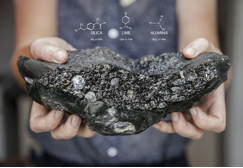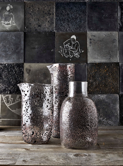A New Life for Plastic
- Zoë Trottier
- Dec 6, 2017
- 2 min read
In an age where sustainability is climbing on society’s list of priorities, research and innovation in the reuse of plastic — a commodity now seemingly essential — is becoming increasingly prominent. I have gathered merely some examples of many in which individuals, ranging from scientists to artists, are developing creative ways in which the more than 300 million tons of plastic products used by humans per year can be renewed.
As stated on her website, Inge Sluijs is a London based artist who creates a material she named Plasma Rock, made from landfill waste found in local landfills in Tilbury and transformed into a crystal-like substance. Sluijs has come up with several purposes for her innovative product, including textured vases, handmade jewelry, art showcased in several galleries and festivals, but most notably a line of indoor tiles made entirely from landfill waste in collaboration with a local tile company. Not only are these tiles aesthetically pleasing, they are also extremely dense and therefore durable. All proceeds from their sales go to the cleaning of soil in 2,964 similar landfills to the one frequented by Sluijs in Tilbury. These landfills are known to contain around 1,655 harmful substances which seep into water streams in surrounding areas, putting local wildlife and vegetation in peril.
This next group of scientists actually uses plastic to create edible fungus. Researchers at Livin Studio cultivate fungal food products using liquid fungus, agar - a “seaweed based gelatin substitute”(Livin) that provides a “nutrient base”(Livin) for the fungus when combined with starch and sugar - and non-toxic plastics. Once the fungus is inserted in Livin Studio’s pod-like machine, it digests the plastic and forms a round, orbic structure which is great to eat! It is also possible to add other ingredients with the agar and plastic to give flavour to this delectable, sustainable food product. Livin Studio hopes soon to be able to sell their “Fungi Mutarium” for household use.
Stella McCartney is a pioneer for sustainable fashion, being one of the first in the industry to place minimal environmental impact as one of her top priorities on her online store. This designer rightfully boasts about her use of polyester fabric made entirely from recycled plastic water bottles. Every piece in her collection is either made from this special polyester, “regenerated cashmere” made from recycled factory wasted cashmere (especially important because cashmere holds the title of having the worst environmental impact of all fabrics) or her “forest friendly” materials (a fabric made from trees managed in a sustainable forest). To date, McCarthy has helped reuse over 2 billion plastic water bottles and transformed them into recycled fabric.

There are countless more examples of how we are learning to reduce our impact, and, as Sluijs eloquently put it, “waste becomes a material when it has a function” - exactly what this new wave of environmental innovators wants to accomplish. We hope to see more ways to renew plastic in the future to further our movement toward lessening our mark on the planet.







